#Fig varieties
Explore tagged Tumblr posts
Text
Fig
The fig tree originated from Mediterranean countries. Turkey is considered a major producer of Fig. These plants are grown in warmer regions. It is also possible to grow in temperate regions with proper indoor temperatures.

Fig tree
Fig tree produce fig fruit and this belongs to the mulberry family. And this is also considered bone friendly because it contains magnesium, calcium, and phosphorous. In, some research it is recommended that it contains 3.2 times more than other fruits.Fig benefits are greater.

Fig varieties
There are almost +800 varieties of figs. But only a few varieties are grown for their delicious purpose.

Black Mission Fig
This fig fruit variety is one of the most commonly grown varieties in the world. The size of the fruit is about 3-5 cm. Initially, the skin seems to be green in color. After ripening it will change to purple or else brown in colour.
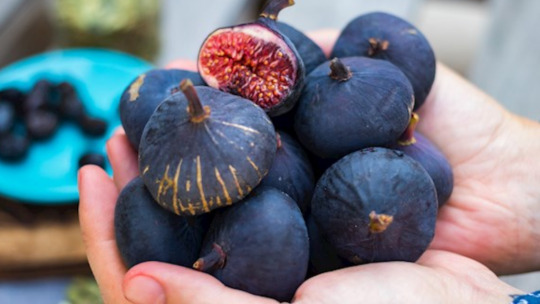
Fig seed
There are more than 1000 seeds found in a fig fruit. Seeds are produced from a single blossom.

Germination
Remove a scoop of pulp and soak in water for two to three days. The true seeds are sediment that is ready to be sown directly and it will germinate quickly.

Soil
Fig prefers to grow mostly in moisture and well-drained soil. Application of Bio-NPK results around the plants results in good yield.

#Fig#The fig tree originated from Mediterranean countries. Turkey is considered a major producer of Fig. These plants are grown in warmer region#fig#Fig tree#Fig tree produce fig fruit and this belongs to the mulberry family. And this is also considered bone friendly because it contains magnesium#calcium#and phosphorous. In#some research it is recommended that it contains 3.2 times more than other fruits.Fig benefits are greater.#fig tree#Fig varieties#There are almost +800 varieties of figs. But only a few varieties are grown for their delicious purpose.#fig fruit varieties#Black Mission Fig#This fig fruit variety is one of the most commonly grown varieties in the world. The size of the fruit is about 3-5 cm. Initially#the skin seems to be green in color. After ripening it will change to purple or else brown in colour.#black mission fig#Fig seed#There are more than 1000 seeds found in a fig fruit. Seeds are produced from a single blossom.#fig seeds#Germination#Remove a scoop of pulp and soak in water for two to three days. The true seeds are sediment that is ready to be sown directly and it will g#germination#Soil#Fig prefers to grow mostly in moisture and well-drained soil. Application of Bio-NPK results around the plants results in good yield.#soil#Irrigation#Drip irrigation is the most suitable irrigation for fig trees. A plant requires at least 13-15 liters of water a day.#irrigation#Sunlight#This plant requires 6-8 hours of direct sunlight. Less amount of sunlight will produce less amount of fruits.
8 notes
·
View notes
Text
Fig
The fig tree originated from Mediterranean countries. Turkey is considered a major producer of Fig. These plants are grown in warmer regions. It is also possible to grow in temperate regions with proper indoor temperatures.

Fig tree
Fig tree produce fig fruit and this belongs to the mulberry family. And this is also considered bone friendly because it contains magnesium, calcium, and phosphorous. In, some research it is recommended that it contains 3.2 times more than other fruits.Fig benefits are greater.
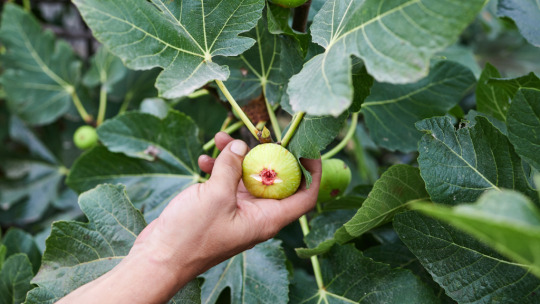
Fig varieties
There are almost +800 varieties of figs. But only a few varieties are grown for their delicious purpose.
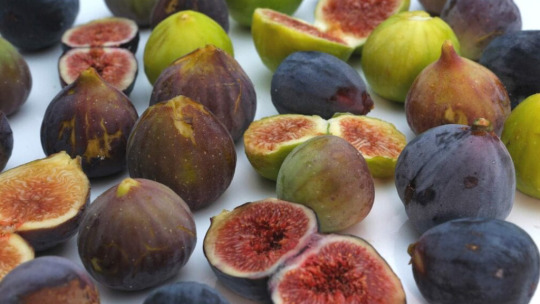
Black Mission Fig
This fig fruit variety is one of the most commonly grown varieties in the world. The size of the fruit is about 3-5 cm. Initially, the skin seems to be green in color. After ripening it will change to purple or else brown in colour.
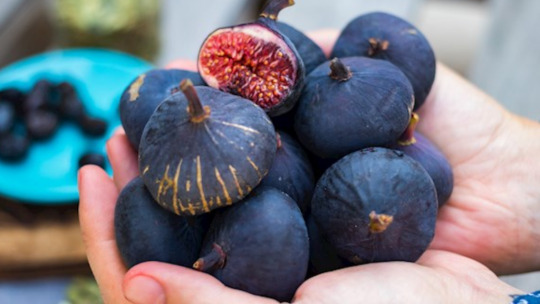
Fig seed
There are more than 1000 seeds found in a fig fruit. Seeds are produced from a single blossom.
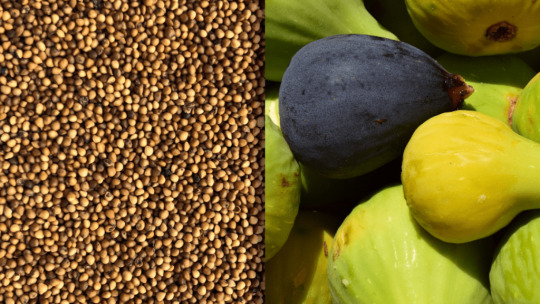
Germination
Remove a scoop of pulp and soak in water for two to three days. The true seeds are sediment that is ready to be sown directly and it will germinate quickly.

#Fig#The fig tree originated from Mediterranean countries. Turkey is considered a major producer of Fig. These plants are grown in warmer region#fig#Fig tree#Fig tree produce fig fruit and this belongs to the mulberry family. And this is also considered bone friendly because it contains magnesium#calcium#and phosphorous. In#some research it is recommended that it contains 3.2 times more than other fruits.Fig benefits are greater.#fig tree#Fig varieties#There are almost +800 varieties of figs. But only a few varieties are grown for their delicious purpose.#fig fruit varieties#Black Mission Fig#This fig fruit variety is one of the most commonly grown varieties in the world. The size of the fruit is about 3-5 cm. Initially#the skin seems to be green in color. After ripening it will change to purple or else brown in colour.#black mission fig#Fig seed#There are more than 1000 seeds found in a fig fruit. Seeds are produced from a single blossom.#fig seeds#Germination#Remove a scoop of pulp and soak in water for two to three days. The true seeds are sediment that is ready to be sown directly and it will g#germination#Soil#Fig prefers to grow mostly in moisture and well-drained soil. Application of Bio-NPK results around the plants results in good yield.#soil#Irrigation#Drip irrigation is the most suitable irrigation for fig trees. A plant requires at least 13-15 liters of water a day.#irrigation#Sunlight#This plant requires 6-8 hours of direct sunlight. Less amount of sunlight will produce less amount of fruits.
0 notes
Text
Fig
The fig tree originated from Mediterranean countries. Turkey is considered a major producer of Fig. These plants are grown in warmer regions. It is also possible to grow in temperate regions with proper indoor temperatures.

Fig tree
Fig tree produce fig fruit and this belongs to the mulberry family. And this is also considered bone friendly because it contains magnesium, calcium, and phosphorous. In, some research it is recommended that it contains 3.2 times more than other fruits.Fig benefits are greater.

Fig varieties
There are almost +800 varieties of figs. But only a few varieties are grown for their delicious purpose.
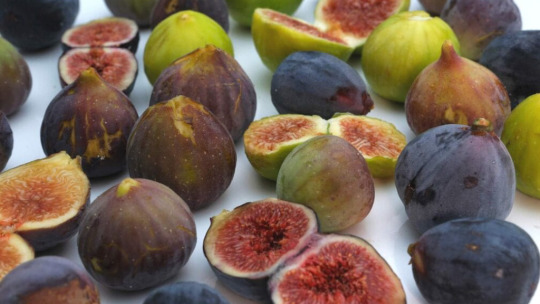
Fig tree
Fig tree produce fig fruit and this belongs to the mulberry family. And this is also considered bone friendly because it contains magnesium, calcium, and phosphorous. In, some research it is recommended that it contains 3.2 times more than other fruits.Fig benefits are greater.

Black Mission Fig
This fig fruit variety is one of the most commonly grown varieties in the world. The size of the fruit is about 3-5 cm. Initially, the skin seems to be green in color. After ripening it will change to purple or else brown in colour.
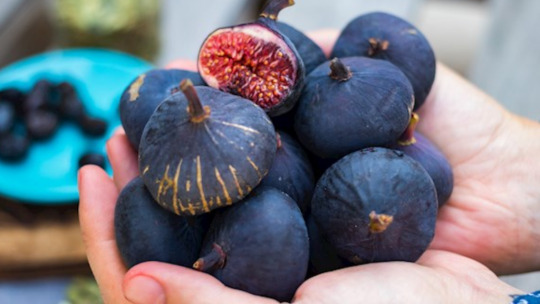
Fig seed
There are more than 1000 seeds found in a fig fruit. Seeds are produced from a single blossom.

Germination
Remove a scoop of pulp and soak in water for two to three days. The true seeds are sediment that is ready to be sown directly and it will germinate quickly.
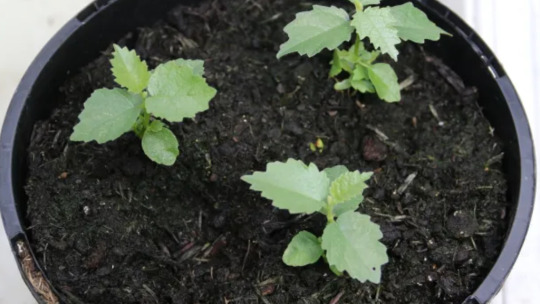
Fig Benefits
Figs are commonly rich in antioxidants which will reduce free radicals.
And also rich in potassium which regulates blood pressure levels.
Taking this fruit in every meal will regulate our body weight because fig is highly rich in fiber.
Figs are highly rich in vitamin A which helps in good vision.
The dried figs leaf is majorly used for diabetes, some skin conditions like vitiligo, & allergies.
Not only this dried figs are rich in anti-oxidants
And the fig benefits are more & essential for our daily life.
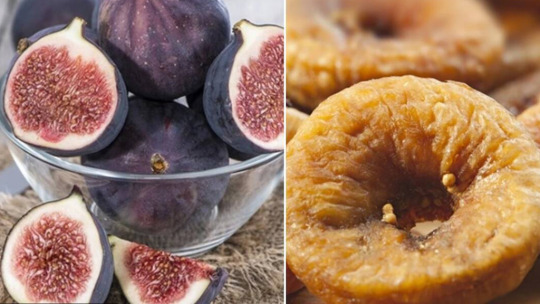
#Fig#The fig tree originated from Mediterranean countries. Turkey is considered a major producer of Fig. These plants are grown in warmer region#fig#Fig tree#Fig tree produce fig fruit and this belongs to the mulberry family. And this is also considered bone friendly because it contains magnesium#calcium#and phosphorous. In#some research it is recommended that it contains 3.2 times more than other fruits.Fig benefits are greater.#fig tree#Fig varieties#There are almost +800 varieties of figs. But only a few varieties are grown for their delicious purpose.#fig fruit varieties#Black Mission Fig#This fig fruit variety is one of the most commonly grown varieties in the world. The size of the fruit is about 3-5 cm. Initially#the skin seems to be green in color. After ripening it will change to purple or else brown in colour.#black mission fig#Fig seed#There are more than 1000 seeds found in a fig fruit. Seeds are produced from a single blossom.#fig seeds#Germination#Remove a scoop of pulp and soak in water for two to three days. The true seeds are sediment that is ready to be sown directly and it will g#germination#Soil#Fig prefers to grow mostly in moisture and well-drained soil. Application of Bio-NPK results around the plants results in good yield.#soil#Irrigation#Drip irrigation is the most suitable irrigation for fig trees. A plant requires at least 13-15 liters of water a day.#irrigation#Sunlight#This plant requires 6-8 hours of direct sunlight. Less amount of sunlight will produce less amount of fruits.
0 notes
Text
Fig
Fig
The fig tree originated from Mediterranean countries. Turkey is considered a major producer of Fig. These plants are grown in warmer regions. It is also possible to grow in temperate regions with proper indoor temperatures.
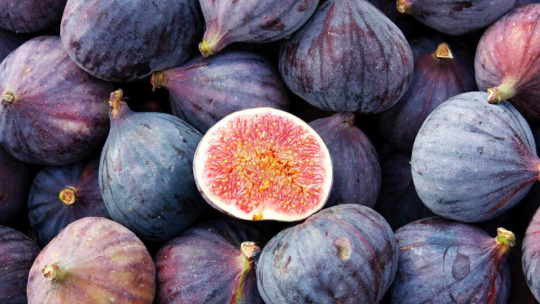
Fig tree
Fig tree produce fig fruit and this belongs to the mulberry family. And this is also considered bone friendly because it contains magnesium, calcium, and phosphorous. In, some research it is recommended that it contains 3.2 times more than other fruits.Fig benefits are greater.

Fig varieties
There are almost +800 varieties of figs. But only a few varieties are grown for their delicious purpose.

Black Mission Fig
This fig fruit variety is one of the most commonly grown varieties in the world. The size of the fruit is about 3-5 cm. Initially, the skin seems to be green in color. After ripening it will change to purple or else brown in colour.
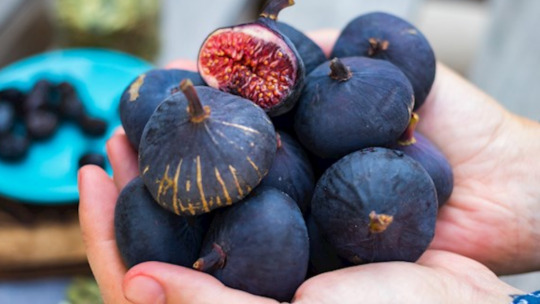
Fig seed
There are more than 1000 seeds found in a fig fruit. Seeds are produced from a single blossom.
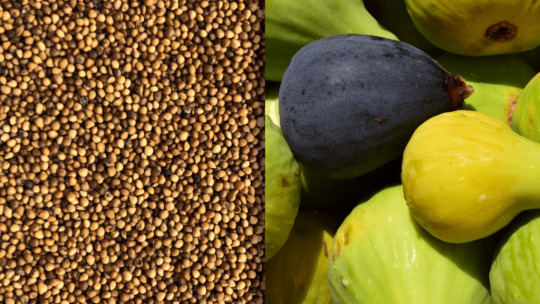
Germination
Remove a scoop of pulp and soak in water for two to three days. The true seeds are sediment that is ready to be sown directly and it will germinate quickly.
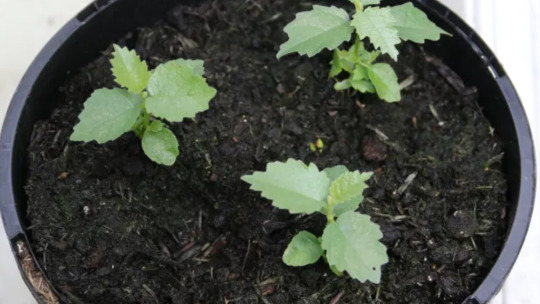
Soil
Remove a scoop of pulp and soak in water for two to three days. The true seeds are sediment that is ready to be sown directly and it will germinate quickly.
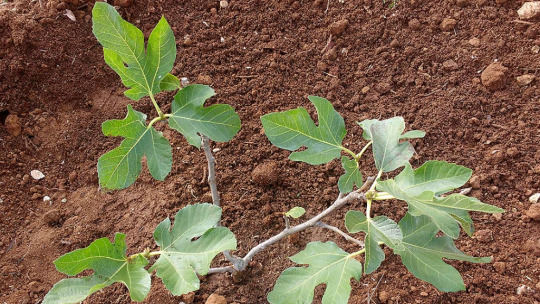
Irrigation
Drip irrigation is the most suitable irrigation for fig trees. A plant requires at least 13-15 liters of water a day.
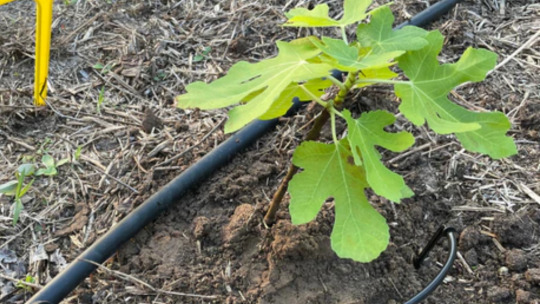
Sunlight
This plant requires 6-8 hours of direct sunlight. Less amount of sunlight will produce less amount of fruits.
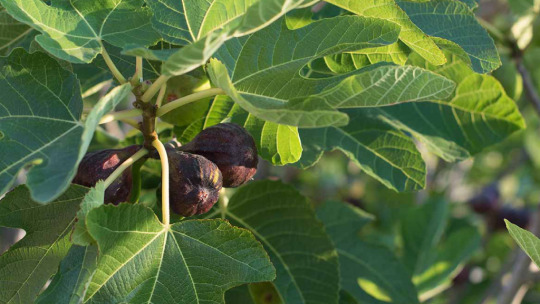
Planting tips
In summer trees should remain in full sun and never forget to add nitrogen fertilizer every 4 weeks. And during winter tend to move the plant to an indoor area with moist soil.

Pruning
In the first year of growth the upward portion trimmed to 50 percent. And so it will grow into a stout and large trunk.

Fertilizer
Application of good organic manure or vermicomposting monthly once around the plant.
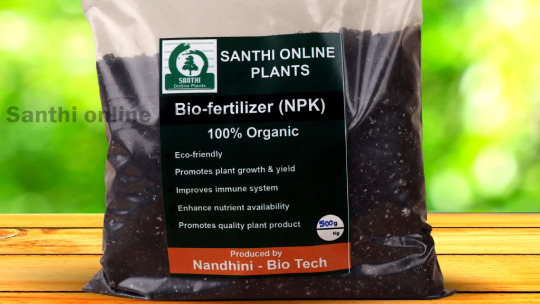
Transplanting
Only two smaller leaves should remain above the pot. After transplanting the cuttings should remain in moist soil.
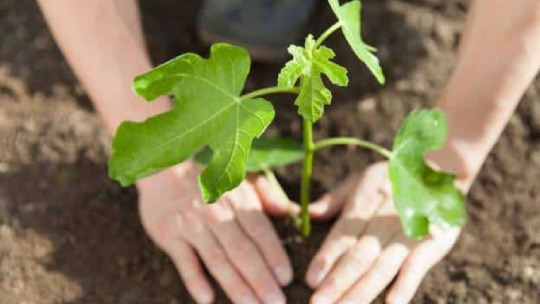
Maturity indices of fig
When the fruits become soft in nature it is the right time to identify their maturity and the neck region will become wilt. If we pick the fruit before its maturity, there is a high chance of the possibility for latex to discharge. Based on the variety of plants the color will change accordingly to its maturity rate. Black mission figs should remain dark purple and calimyrna figs should remain light yellow in color to find their maturity stage.

Harvesting time
Based on weather conditions harvest time varies. In, summer time we can expect a harvest at two times. One in June month and another one in August

Fig Benefits
Figs are commonly rich in antioxidants which will reduce free radicals.
And also rich in potassium which regulates blood pressure levels.
Taking this fruit in every meal will regulate our body weight because fig is highly rich in fiber.
Figs are highly rich in vitamin A which helps in good vision.
The dried figs leaf is majorly used for diabetes, some skin conditions like vitiligo, & allergies.
Not only this dried figs are rich in anti-oxidants
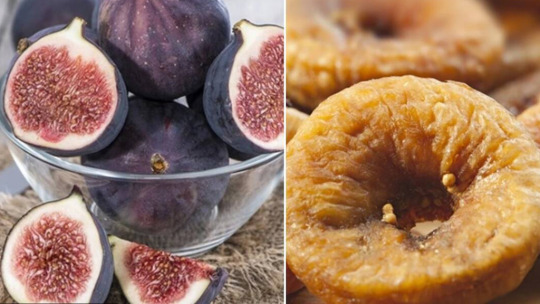
#Fig#The fig tree originated from Mediterranean countries. Turkey is considered a major producer of Fig. These plants are grown in warmer region#fig#Fig tree#Fig tree produce fig fruit and this belongs to the mulberry family. And this is also considered bone friendly because it contains magnesium#calcium#and phosphorous. In#some research it is recommended that it contains 3.2 times more than other fruits.Fig benefits are greater.#fig tree#Fig varieties#There are almost +800 varieties of figs. But only a few varieties are grown for their delicious purpose.#fig fruit varieties#Black Mission Fig#This fig fruit variety is one of the most commonly grown varieties in the world. The size of the fruit is about 3-5 cm. Initially#the skin seems to be green in color. After ripening it will change to purple or else brown in colour.#black mission fig#Fig seed#There are more than 1000 seeds found in a fig fruit. Seeds are produced from a single blossom.#fig seeds#Germination#Remove a scoop of pulp and soak in water for two to three days. The true seeds are sediment that is ready to be sown directly and it will g#germination#Soil#Fig prefers to grow mostly in moisture and well-drained soil. Application of Bio-NPK results around the plants results in good yield.#soil#Irrigation#Drip irrigation is the most suitable irrigation for fig trees. A plant requires at least 13-15 liters of water a day.#irrigation#Sunlight#This plant requires 6-8 hours of direct sunlight. Less amount of sunlight will produce less amount of fruits.
0 notes
Text
hey do you think figs are vegan
#if you enjoy figs and are easily grossed out STOP READING HERE#this is a filler tag to hide the below tags just in case#because a lot of figs are pollinated by wasps that die inside the fig#so with some varieties of fig you are likely to eat a wasp#a wasp is not vegan#therefore are wasp-pollinated figs that contain dead wasps vegan?#i don't want to have a debate about the ethicality of veganism or anything#i was just thinking about this and got curious
8 notes
·
View notes
Text
Local pizza place is having a special offer on what they call a Canadian pizza. Which contains, among other things, hearts of palm and catupiry cheese. Both of which I am certain no Canadian has ever put on a pizza on account of they literally do not exist there.
#life of dan#ah brazil#theres also the californian pizza#which has pineapple of course but also mango and fig#and no it is not a dessert pizza#you can get hearts of palm in canada in immigrant shops#but catupiry is a brazilian brand of cheese#and they make their cream cheese in a very particular way#that is completely differnt to regular cream cheese#to the point it is considered its own variety of cheese#and you cannot find it there
3 notes
·
View notes
Text


Anotha one
#i cant wait for skypiea zoro to get here#i love his pants in this fig#i wanted a variety so bad bc so many of his figs are exactly the same
1 note
·
View note
Text
Fig Varieties Thriving With Intermittent Downpours
Summer has been mostly dry with occasional rain, which is typical for this region. This rainfall pattern can cause figs to drop or dry out during prolonged dry spells. Conversely, sudden heavy rains can lead to excess water, causing ripe figs to spoil or crack, resulting in potential harvest loss. Certain fig varieties thrive in these conditions despite these issues, adapting well to weather…
0 notes
Text

There's my high nature fact for the night. 😳
#Did you know some varieties of fig actually contain wasps? you're welcome.#(don't worry. the fig actually digests it all and incorporates it into the ripe fruit.)
1 note
·
View note
Text
i need to pivot the trading figures i collect away from modern ones (TINY tiny) and more towards older ones. my bandai duck+rue, hgif sos brigade members, toys works illya, chara ani arc and trading arts lau TOWER over my mega cat projects, utatanes, niitengos and nendo petits and tbh i do kinda really prefer the bigger size
#and obv i have a lot of tiny tiny older trading figs too but like. that size is the only option for modern trading figs#when there used to be a variety#romeo.txt
0 notes
Text
Fig
The fig tree originated from Mediterranean countries. Turkey is considered a major producer of Fig. These plants are grown in warmer regions. It is also possible to grow in temperate regions with proper indoor temperatures.
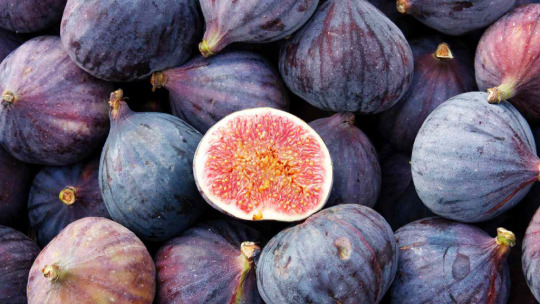
Fig tree
Fig tree produce fig fruit and this belongs to the mulberry family. And this is also considered bone friendly because it contains magnesium, calcium, and phosphorous. In, some research it is recommended that it contains 3.2 times more than other fruits.Fig benefits are greater.

Fig varieties
There are almost +800 varieties of figs. But only a few varieties are grown for their delicious purpose.

Black Mission Fig
This fig fruit variety is one of the most commonly grown varieties in the world. The size of the fruit is about 3-5 cm. Initially, the skin seems to be green in color. After ripening it will change to purple or else brown in colour.There are almost +800 varieties of figs. But only a few varieties are grown for their delicious purpose.
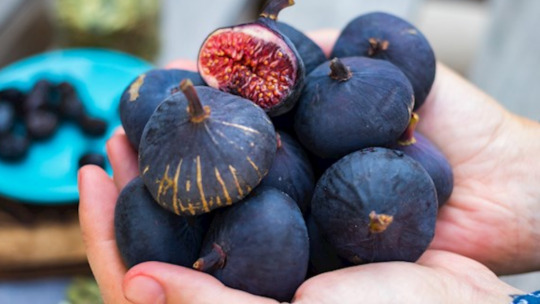
Fig seed
There are more than 1000 seeds found in a fig fruit. Seeds are produced from a single blossom.
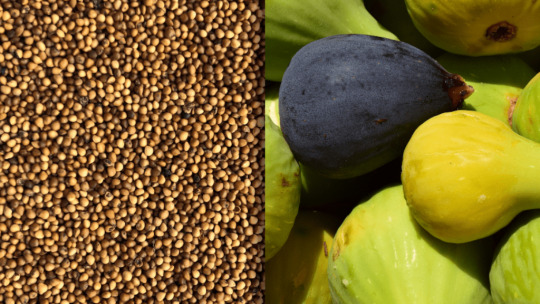
Germination
Remove a scoop of pulp and soak in water for two to three days. The true seeds are sediment that is ready to be sown directly and it will germinate quickly.
#Fig#The fig tree originated from Mediterranean countries. Turkey is considered a major producer of Fig. These plants are grown in warmer region#fig#Fig tree#Fig tree produce fig fruit and this belongs to the mulberry family. And this is also considered bone friendly because it contains magnesium#calcium#and phosphorous. In#some research it is recommended that it contains 3.2 times more than other fruits.Fig benefits are greater.#fig tree#Fig varieties#There are almost +800 varieties of figs. But only a few varieties are grown for their delicious purpose.#fig fruit varieties#Black Mission Fig#This fig fruit variety is one of the most commonly grown varieties in the world. The size of the fruit is about 3-5 cm. Initially#the skin seems to be green in color. After ripening it will change to purple or else brown in colour.#black mission fig#Fig seed#There are more than 1000 seeds found in a fig fruit. Seeds are produced from a single blossom.#fig seeds#Germination#Remove a scoop of pulp and soak in water for two to three days. The true seeds are sediment that is ready to be sown directly and it will g#germination#Soil#Fig prefers to grow mostly in moisture and well-drained soil. Application of Bio-NPK results around the plants results in good yield.#soil#Irrigation#Drip irrigation is the most suitable irrigation for fig trees. A plant requires at least 13-15 liters of water a day.#irrigation#Sunlight#This plant requires 6-8 hours of direct sunlight. Less amount of sunlight will produce less amount of fruits.
0 notes
Text
It’s sunny & warm enough to be in short sleeves today. I cleaned my room did all the dishes swept the front stairs watered the plants did laundry went to the farmers market bought too many oranges (then ate too many oranges) played music full volume & sang along bc no one else is home. Yesterday I walked to the beach & in the wet sand until I got blisters. I found 2 big sand dollars and put them on the steps to dry out. Now I’m barefoot and bare shouldered with all the windows open & my neighbor is playing guitar & it’s coming through the walls & I think actually everything might be alright!!!!
#god the weeks of rain cold fog and no fun due to#school and work#did a doozy on my mood I think#I love the world again!! I feel the whimsy#I feel the joy in the little things#I walked past a tree of grackles screaming at eachother and laughed#I met a women at the bust stop when I was taking out the trash at like 8am#and she told me how to make soup using the variety of figs we have in the yard#I told her we don’t water the trees so the texture of the fruit is bad#she gave me advice on how to water them but keep it drought freindly :)#the world is full of good!!!#my brain is full of dopamine!!!#and now…time to walk to the library and sit inside for 6 hrs doing lectures & readings lol
1 note
·
View note
Text
Got fig jam for the first time ever and. Yeah I get why it's like one of the foods of the gods or whatever
#the little local market usually has a variety of fruit jams but they only had fig and pumpkin butter for the past few weeks#and bc it's oriole season we just ran out of grape jelly#and i need SOMETHING for my pbjs so i caved and got the fig jam#and. oh god i didn't expect it to be that good. fuck it's so good#i just made a little quesadilla w some jam and sharp cheddar and. as i licked my fingers clean i understood
1 note
·
View note
Text

The Foods of Dragon Age: The Veilguard
This covers all the new foods mention in the game, unless noted otherwise, these foods are considered universal as they don't have a specific place of origin mentioned.
New Ingredients:
Alubia carilla - Antivan, aka blacked eyed peas
Antivan Lemon Thyme
Apricot
Cheese Curds
Chocolate, Dark
Clinging Morsel - a hearty fungus that is common in rural cuisine
Cow Heart
Cream, Heavy
Dragon's Bounty - known for its health benefits, it has tough green skin that opens and reveals dozens of tart arils.
Dragon Pepper - Rivain
Dragon Root
Dwarf Spice Collection - contains eight different spices.
Flax Seed
Figs, Purple
Ginger Root - a popular ingredient in Qunari cuisine
Gingerwort Truffle - common in the Anderfels and the Arlathan forest. When made into a tea it can have some magical side effects.
Green Cabbage
Horned Melon
Human Spice Collection - a collection with two spices
Kale
Lineseed
Mangos - Tevinter
Melon
Nocen Bass - a hearty denizen of the Nocen Sea
Nocen Shrimp
Olive Oil - Antivan
Pineapple - Tevinter and Rivain
Potatoes, New
Potatoes, Sweet
Pumpkin, Warty
Rialto Trout - a fish featured in both Antivan and Rivaini cuisine
Rivaini Pitaya - a colourful fruit with a sweet, delicate flavor. Though pitaya refers to dragonfruit family, the fruit doesn't look like dragonfruit.
River Salmon
Saffron
Sea Bass
Seere Peppers - Rivaini
Short-grain Rice - Antivan
Spearmint
Spicy Spice Collection - contains fourteen jars
Spring Onions
Striped Cod
Sugar, Brown
Sweetmelon
Tomatoes, Cherry
Vinegar, Dark
Vinegar, White
Walnut
Yam
New Foods:
Aged Antivan Cheese
Antaam Provisions
Antivan Dressing
Antivan Seafood Soup - uses sea bass, nocen shrimp, striped cod, squid, saffron, and salt
Apple Cake - Fereldan
Apple Cheesy Butter Noodles - Fereldan, a recipe made by Harding
Apple Dumplings - Fereldan
Apricot Liqueur
Armada Special - a Rivaini sandwich comprised of meat and cheese, it can have greens, pineapple, and more meat and cheese added. Or one can make it "Nevarran" meaning vegetarian.
Bran Cookies
Breaded Cheese Wands - Rivain, sticks of cheese breaded
Breadstick
Bronto Steak
Bug-cakes
Candied Sage Leaves - a popular Nevarran snack
Carta Fries - a Riviani dish, served as a side
Cheesy Toast
Chocolate Covered Strawberries
Churro - Antivan
Cider Porridge
Citrus Bagna Cauda - Antivan, a citrus sauce with anchovies
Coffee Ice - a frozen Minrathous treat, served with cream and toffee sauce on top. It is "like snow" but tastes of coffee
Cucumber sandwich
Dalish Seafood Soup
Deep Roads Crispers - a Rivaini dish
Demon-hair pasta
Eel Soup - Qun
Elderberry Pie - served in Ferelden and Tevinter
Elfroot Jelly
Fish Head Stew - Qun
Fish of the Day with Pear Slaw - Tevinter
Fish-fry
Free Marches Mash-up - a Rivaini dish
Fried Bread
Fried Bread with Herbs
Fried Leeks and Potatoes
Fried Peppers
Fry-bread - Tevinter
Gooseberry Pie
Gravy on Fish
Greens - salad
Greens with Antivan, Orlesian, or House Dressing
Griddle Cake
Grilled Fish Kebab
Grilled Halla - Dalish
Grilled Skewerd Squid
Grilled Treviso - Antivan, a fish named after the city
Grilled Treviso with Citrus Bagna Cauda
Hal's Fried Fish - Tevinter
Halla Cakes - Dalish
Ham and Herbs
Ham and Jam Slam - a Fereldan sandwich comprised of toast, butter, ham, and jam. Made by Harding.
Hazlenut Torte - Nevarran
Honey Cake with Figs - Tevinter
House Dressing - a Rivaini dressing
Isskap - a Qunari dish, that uses melons
Jam Pudding - Fereldan
Jam Tart - Fereldan
Jam, Apple
Jam, Cherry
Jam, Strawberry
Khachapuri - Tevinter, there is a three cheese variety
Lavender Cream - Antivan
Mince Pie
Mutton Stew - Fereldan
Mystery Stew
Nevarran Tomb Cheese
Non-Seafood Paella - Antivan
Noodles and Gravy
Nordbotten Cream - made of brined sheep's milk from Nordbotten
Orange Liqueur
Orlesian Dressing
Orlesian Sauce
Pasta Made of Peppers and Oil
Peanut Butter and Sausage Special - Tevinter
Pear Slaw - Tevinter
Peppered Steaks
Poached Crustaceans - Tevinter
Pork Dumplings - Fereldan
Pork Hand Pies with Fresh Herb Sauce - Tevinter
Potato Stew
Poutine
Rarebit - Nevarran
Raw Oysters on Ice with Lemon and Mint - Tevinter
Rhubarb Pie - Tevinter and Fereldan
Roasted Cabbage
Roasted Cabbage and Gravy
Roasted Chicken
Roasted Chicken Salad
Robust Loaf - a crusty, wholesome brown bread
Rolled Noodles
Salted Meat, Halla
Sauced Eels - Qunari
Sausage Sauced with Nut Butter Stuffed in a Bun - Tevinter
Savory Pie with Spinach - Tevinter
Scorpion Pasta - Tevinter
Scrambled Eggs
Scrambled Eggs and Gravy
Sea Monster Kebab - Rivaini
Seafood Paella
Seleny Ham - Antivan
Smoked Trout
Souffle
Spiced Fried Lentils - Tevinter
Spiced Porridge
Spit-Roasted Nug - Tevinter
Strawberry Tart
Street Meat
Sugar-biscuit Candy
Tarta de Limon - Antivan
Taste of Ferelden Bread and Cheese Spread
Tentacle Salad - Tevinter
The Divine's Hat - An Orlesian soft cheese molded to resemble the Divine's crown.
The Revered Mother's Knickers - Fereldan
Treviso Ham - Antivan
Turnip Stew - Fereldan
Vanilla and Nutmeg Tart
Venison Souffle
White Sauce
Wild Meat and Mushrooms - Dalish
Yam and Jam Slam - a Fereldan sandwich comprised of toast, butter, yam, and jam. Made by Harding.
Zeff's Fried Fish
New Drinks
Andoral's Breath - a type of coffee common in Treviso
Antivan Heritage Brandy
Antivan House Wine
Aromatic Coffee - Antivan
Assembly Ale - Dwarven
Cioccolata Calda - Antivan
Daisy Fun-Time Lemon Gin - Antivan, a juniper spirit flavoured with local flowers and fruit.
Dew of the Dales - Elven, Antivan. Spirits for the spirited, an elven elevation of the brewing arts only sold in Antiva.
Dock Town Homebrew - Tevinter
Dragon Piss Ale
Dwarven Stout - an Orzammar recipe, brewed by the dwarven Ambassadoria
Fire Brandy - used to flambé desserts
Ginger Tea
Gingerwort Truffle Tea
Grappling Hook - a white liqueur with hints of elderflower. Served with three coffee beans
Halla Milk
Kirkwall Select 9:36 - after the Kirkwall Rebellion, few barrels survived.
Lavender Tea
Lemon Gin - Antivan
Minrathous Red - hints of plum and spices
Minrathous White - a light and refreshing drink for humid Tevinter summers
Nevarran Red
Pomace Brandy - Antivan, brandy made from the pomace leftovers of wine making
Qun on the Rocks - Antivan, rum is matched with salt water and presumably seasonal fruit from Par Vollen.
Rivaini Moonshine - home-distilled Rivaini moonshine not for the faint of heart or stomach
Starkhaven Lager
Teven Lager - popular Dock Town amber brew
Vint-6 the common Red - thick and sweet, it is served by the sip. Tradition says that the more who partake, the greater the fortune
Vyrantium Brandy
#dragon age#foods of thedas#dragon age the veilguard#dragon age 4#datv#da4#anderfels#antiva#dalish#nevarra#rivain#tevinter#long post
300 notes
·
View notes
Text
I see at least one cool bug a day, and usually many more, but it’s not because I live anywhere particularly rich in strange, wonderful creatures (I live in an unremarkable corner of Pennsylvania, USA) or spend all of my free time looking for bugs (well, just *most* of it). in my experience, finding interesting bugs is less about actually locating them and more about looking closely at tiny things you’d otherwise ignore!
this very long post was compiled over a couple days in late July, although I spent less than 10 minutes at a time searching. there’s a lot of fun creatures just out in the open.

plants are always a good place to start when looking for bugs, and I chose this small fig tree (Ficus carica) with a mulberry sapling friend. feeding on the sap of the fig and mulberry is the first group I’ll take a look at, the planthoppers:

these two are flatid bugs, Metcalfa pruinosa and Flatormenis proxima. flatids are slow-moving bugs that can be approached closely, but once they get tired of circling around stems to avoid you they may launch themselves into a fluttering flight with spring-loaded rear legs.
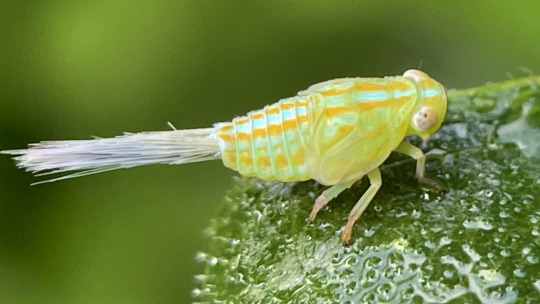
Aplos simplex, a member of the related family Issidae, also likes fig sap. its “tail” is actually a tuft of waxy secretions, which get shed along with the bright colors when it assumes a lumpy, bean-shaped adult form.
cicadellids, or leafhoppers, are just about everywhere on plants, but can be hard to approach without scaring them.


Agallia constricta on the left is a tiny species that feeds on grass, but many were scared up onto the fig by my footsteps. Jikradia olitoria is a much larger species that does feed on the fig; juveniles like this are curled, creeping goblins while adults’ rounded wings give them a pill-shaped appearance.

this big, pale leafhopper belongs to genus Gyponana. it’s tricky to get to species ID with these.
Graphocephala are striking little hoppers that eat a variety of native and nonnative plants. G. coccinea is the larger, more boldly colored one and G. versuta is smaller but more common locally. they’ll sit on the tops of leaves but take flight if you get too close quickly.
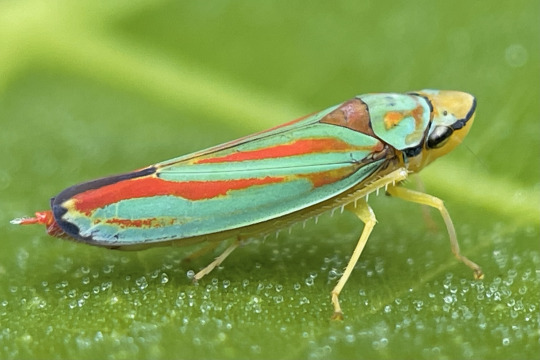
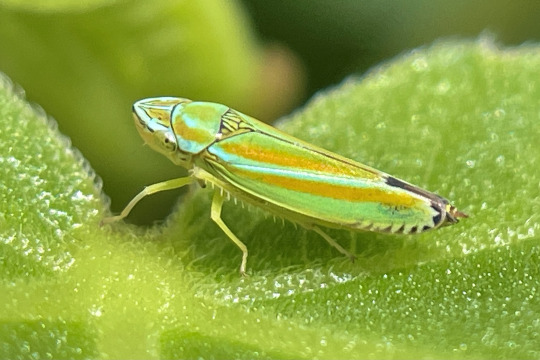
another group you’re almost guaranteed to encounter are flies (Diptera). these are a very diverse group, so much more than houseflies and mosquitoes (though I did run into both)
where I live, any plant with broad leaves is almost guaranteed to have a few Condylostylus, long-legged flies that come in shades of blue, green, and red. despite their dainty physique, they’re agile predators, typically feeding on other small flies.
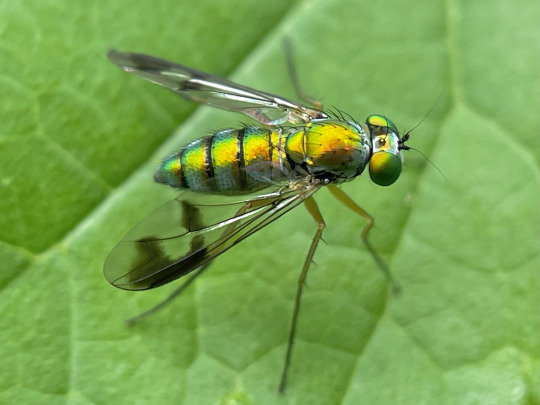
next, a few hoverflies: the ubiquitous Toxomerus geminatus and a Eumerus that I’ve been seeing a lot of this year (but maybe I’ve just noticed them for the first time). syrphids have varied life histories, but most adults drink nectar and many of the larvae are predaceous on aphids.
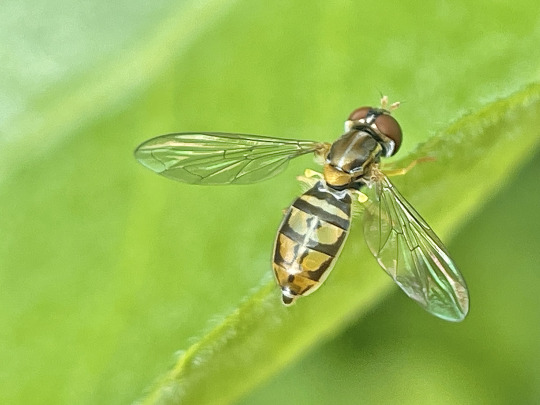
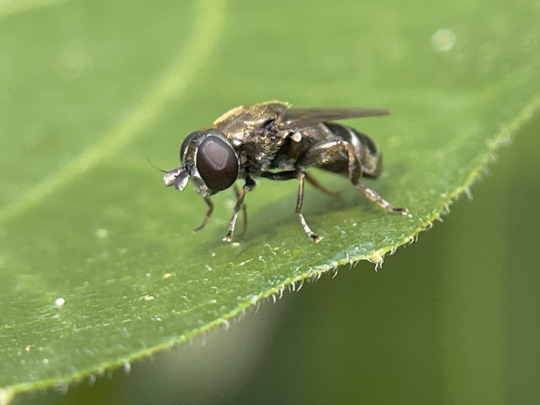
the metallic green soldier fly is Microchrysa flaviventris, nonnative here. Coenosia is a fun example of a “fly that looks like a fly,” with big red eyes and a gray body, and you might think they’re just another dung-sucking pest, but they’re actually aggressive predators! this one seemed to have nabbed itself some sort of nematoceran fly, maybe a fungus gnat.
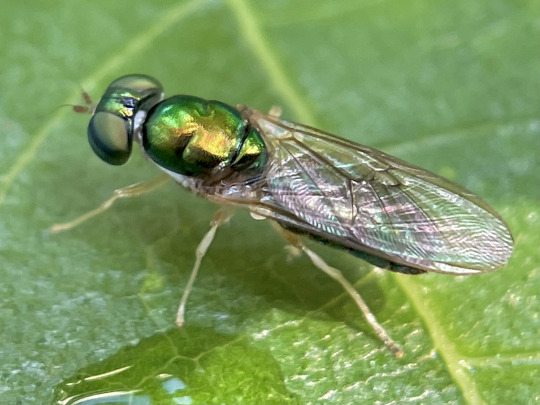

many flies are very tiny, just millimeters long. the first two little fellows are lauxaniids, while the last one, an agromyzid leafminer Cerodontha dorsalis, burrows through grass leaves as a larva.
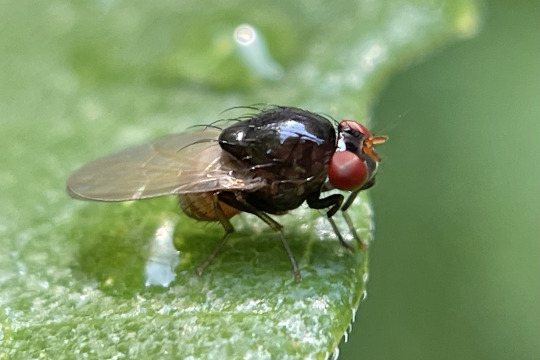
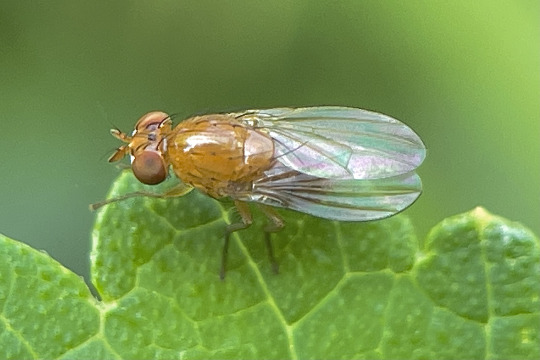

while moths and butterflies (Lepidoptera) are drawn to plants for their flowers or to lay eggs, many small moths can easily be found resting on or under leaves during the day.
these first two are tortricids, many of which are flat, rectangular moths resembling chips of bark or dead leaves. the apple bud moth, Platynota idaeusalis, feeds on a wide variety of hosts, while this beat-up old Argyrotaenia pinatubana would have developed in an edible tube nest of pine needles.


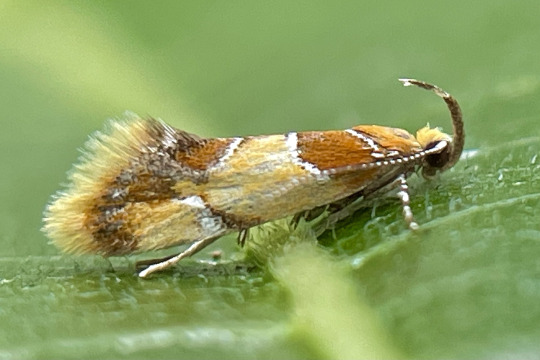
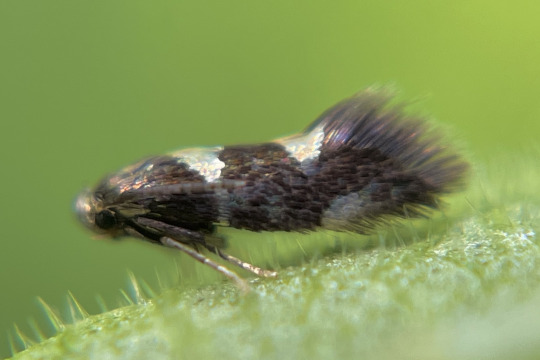
Callima argenticinctella feeds in bark and dead wood (a resource used by more caterpillars than you’d realize!) while the last moth, possibly an Aspilanta, is a leafminer.
although beetles (Coleoptera) are famous for their diversity, I didn’t find too many on the fig. the invasive Oriental beetle Exomala orientalis resting here can be found in a wide range of colors, from this common tan to to deep iridescent black. the other beetle is a Photinus pyralis firefly, sleeping under leaves as fireflies do.
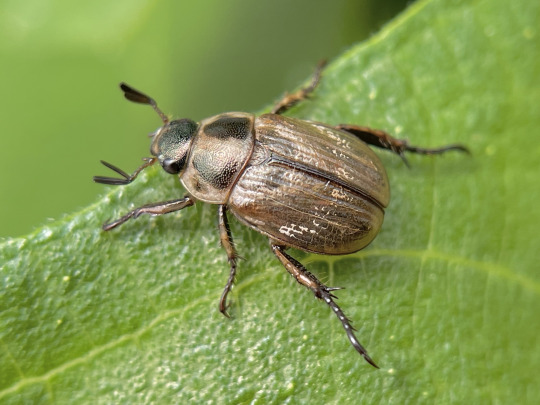

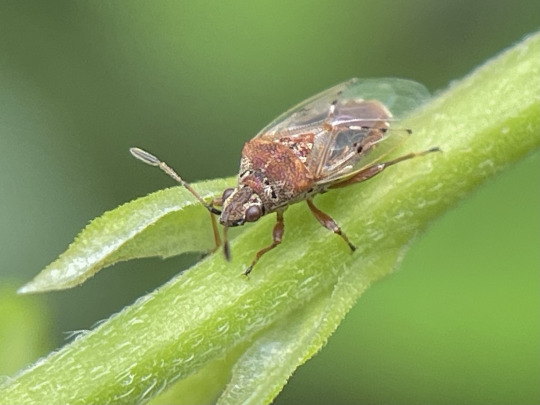
a few spare hemipterans: a Kleidocerys resedae that blew in on a wind, and below, the mulberry whitefly Tetraleurodes mori feeds on its namesake host. as for Hymenoptera, I saw manny tiny parasitic braconid wasps and various ants attracted to the planthoppers’ honeydew excretions—always worth checking underneath roosting hoppers for things having a drink.

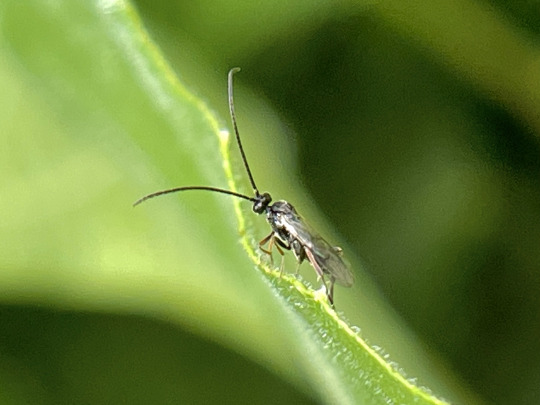
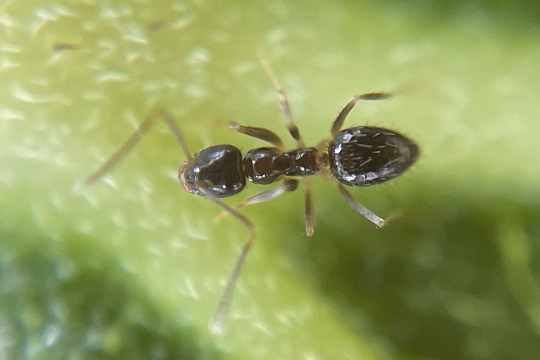
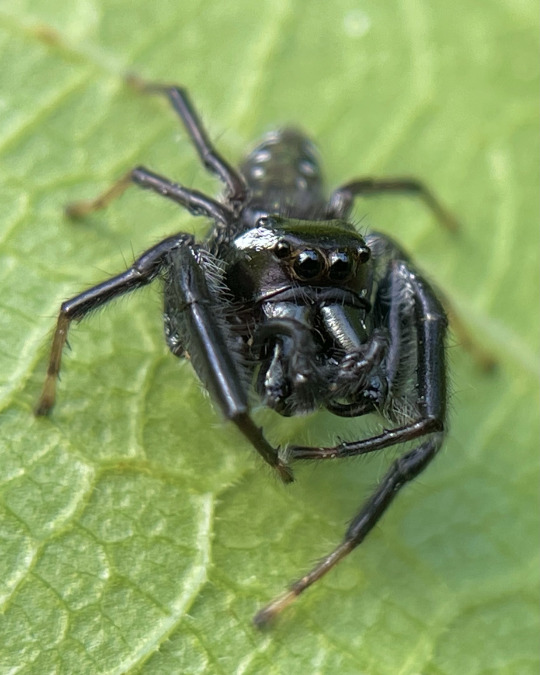
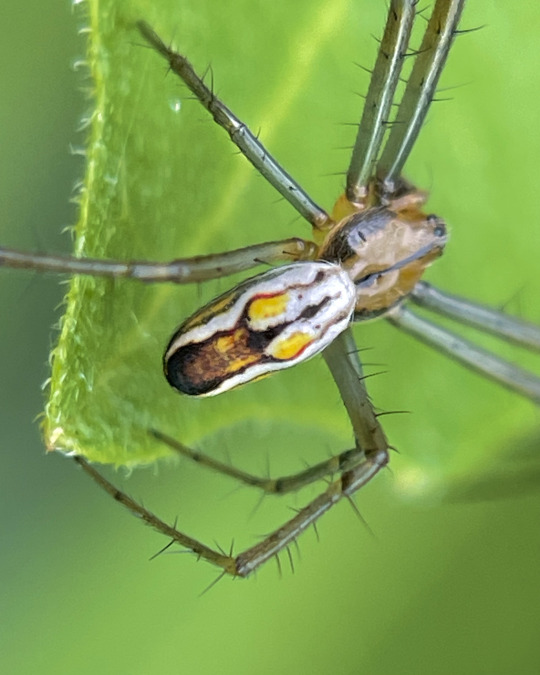
a couple handsome spider boys were scrambling through the fig seeking females, a jumping spider Paraphidippus aurantius and an orbweaver, Mecynogea lemniscata.
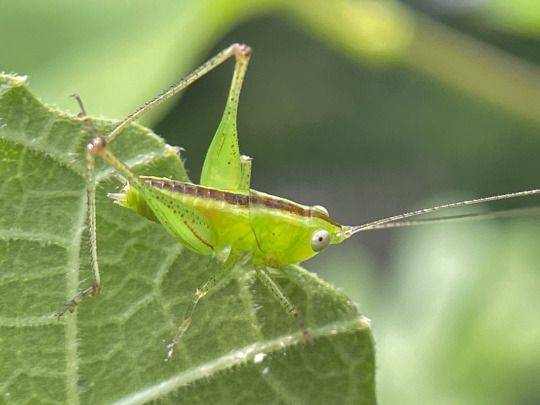
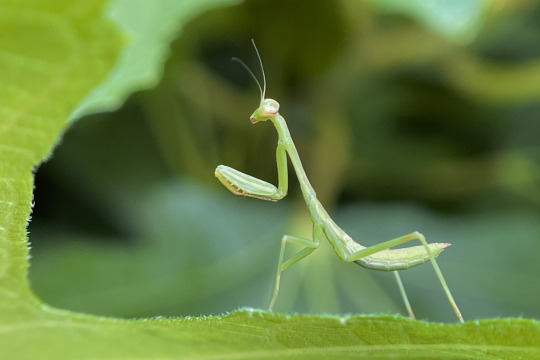
and to round it off, a young Conocephalus meadow katydid and a Carolina mantis, Stagmomantis carolina.
there’s 31 species of arthropod in this post, and I probably saw some 45, not all of which stayed for photos. if you walk slowly and look closely, you can see a sizeable chunk of your local biodiversity in under fifteen minutes! of course this will depend on where you live and what time of year it is, but there’s almost always more cool bugs out there than you’d expect, even on just a single plant.
1K notes
·
View notes
Note
It makes me incredibly angry when people say "Riz is canonically aro/ace" and act like you're a horrible person if you ship him with people. Like. Nowhere in the show is it ever stated that he's aro/ace. The conversation people reference as him being "canonically" aro/ace is just him expressing his lack of very specifically sexual attraction, and even then the response from his dad (and by extension Brennan and the show as a whole) is that it's okay, and that it's specifically unclear whether he's ace or whether it's just not something that's happened for him in specific yet. It is intentionally vague as to whether he is ace or not, and there's genuinely zero indication in the show that he's aro other than that he doesn't have a love interest which could be completely unrelated.
Right so I'd like to share my opinion on this for a brief moment. I am still fully here to give people a voice, but this is just, an issue that kinda hits close to home since I'm demiaro.
The most annoying thing in a lot of media is when representation is shoehorned in as a list of labels and buzzwords we're given. Queer people should not have to turn to the screen and say their full identity in order for them to be canonically queer. That's what subtext is for. That's what good writing does. Is not spell it out for you when it's not necessary to do so. They do not need it to be spelt out for it to be very clear that he's ace/aro.
I am going to assume ignorance here instead of assuming malicious intent. The idea that the reason he isn't ace, is because "it's not something that's happened for him in specific yet", is an extremely common thought process behind asexual erasure. I'm sure that's not what you intended, but that is something to reflect on in general.
Both Adaine and Riz have yet to have relationships or display crushes (not counting junior year since most of the evidence comes from sophomore year) . Adaine hasn't gotten an entire nightmare sequence / arc around dealing with here friends all finding partners and leaving them alone. Adaine hasn't expressed or had conversations about any lack of sexual or romantic feels to the extent Riz has. Adaine is headcanoned as ace/aro by some people. Riz is more than that. Riz is very much canonically ace/aro if you do the slightest bit of character analysis. There's accidental coding and then there's Riz Gukgak.
List of every single Riz trait that is hella ace/aro coded
A lack of sexual and romantic attraction to other people (I'm not counting the time where he said he was kinda into Sexy Rat, that whole scene was a bit, and absolutely insane)
Making up a partner/crush in order to fit in (I have 1000% done that and so have a lot of acespec and arospec people)
A fear of being left behind by his friends because of a belief that they will find partners and move on from him, largely caused by alloromantic culture's insane emphasis on how the most important relationship is a romantic one
The fact that almost every other fantasy high pc has been in a relationship or a crush (kristen had tracker and gertie, gorgug had zelda, unit, and mary ann, fabian had aelwyn, ivy, and mazey, adaine had oisin and possibly zayn depends on your interpretation, and fig has had ayda and a string of professionals in a variety of fields across seasons 1 and 2) with only riz as a single character
The fact his sophomore year arc was entirely about his lack of sexual/romantic attraction and fear of being left alone because of it
Like not even a joke, it was that and his dad, that was the whole arc
His junior year arc was also about his obsession to stay together as a friend group, which like I mentioned above, is very clearly based in his asexuality and aromanticism
I am not going to stop people from shipping characters ever. If you want to rewrite character sexualities, that's fine by me, I'm a big believer in "Don't Like, Don't Read". I am not gonna pretend like characters are not their sexuality in canon so that people feel justified in writing their stories. People who rewrite character sexuality can do so without making everyone else assuage their guilt for them. I know I'm on the "piss on the poor" reading comprehension website, but it's not hard to tell Riz is ace/aro in canon, and pretending otherwise doesn't help your case.
#ask#dropout#dropout tv#dimension 20#d20#dimension twenty#riz fantasy high#riz d20#fabian x riz#riz x fabian#pok gukgak#riz gukgak#d20 fantasy high#dimension 20 fantasy high#dimension20#fantasy high spoilers#fantasy high#adaine abernant#adaine o'shaughnessey#adaine fantasy high#brian murphy#bleem#brennan lee mulligan#siobhan thompson#fantasy high sophomore year#dimension 20 fhsy#fantasy high junior year#d20 fhjy#fhjy spoilers#dimension 20 fantasy high junior year
182 notes
·
View notes